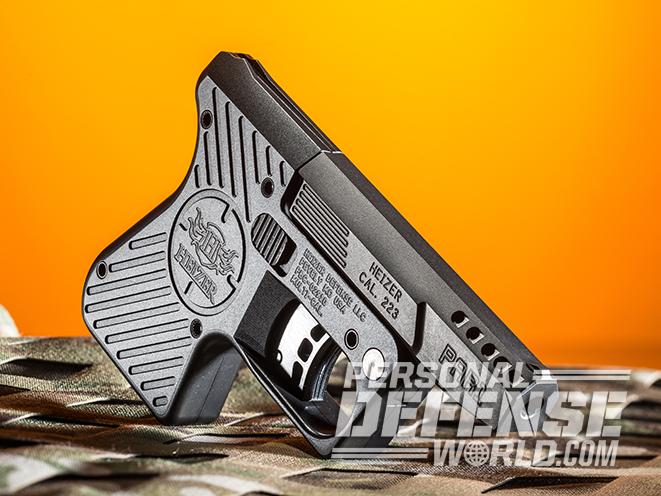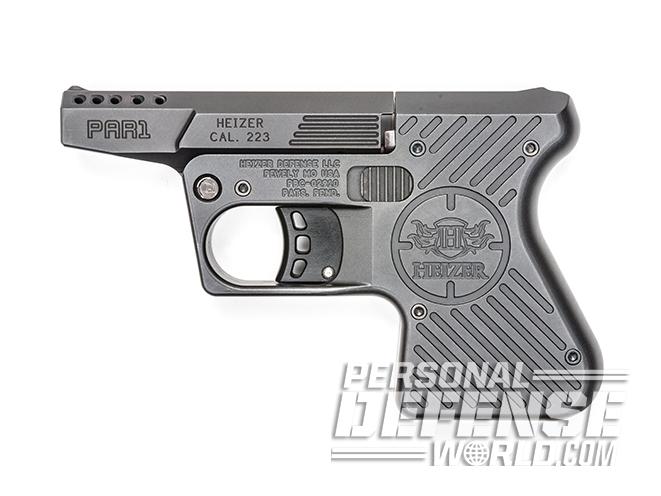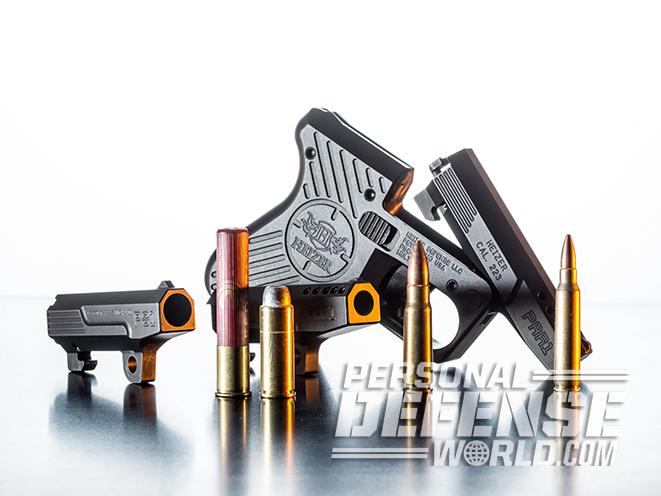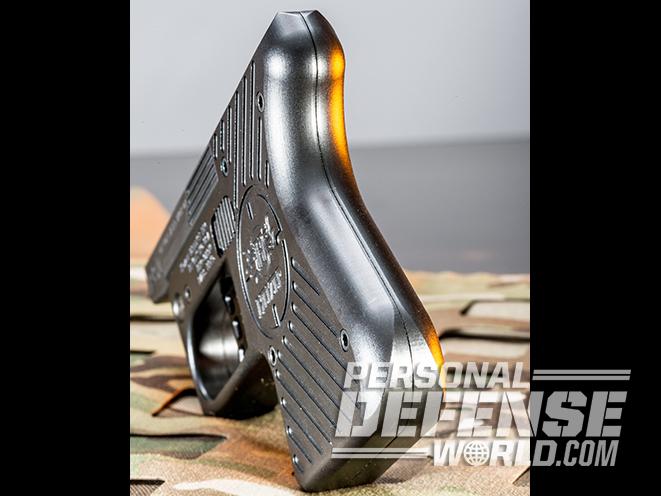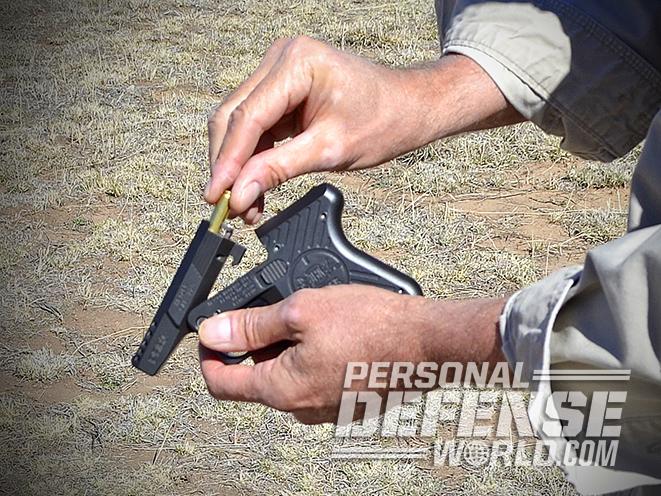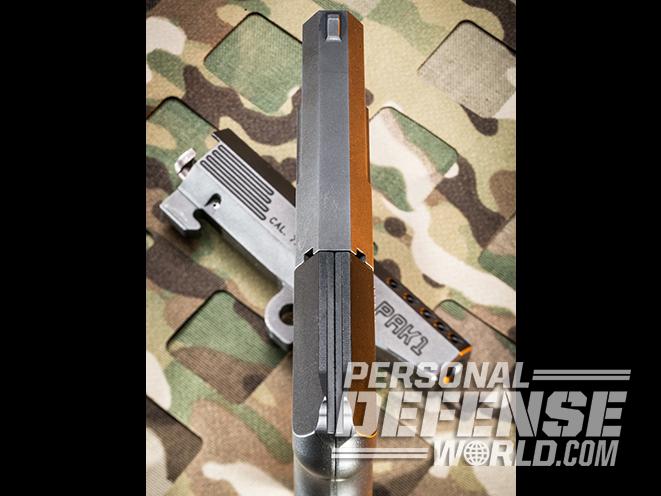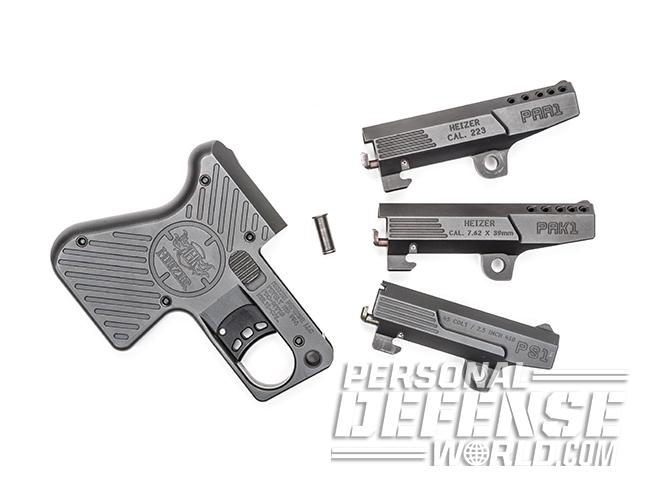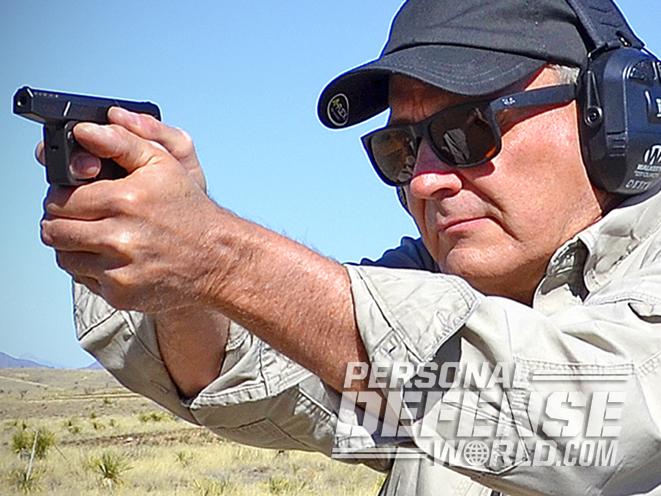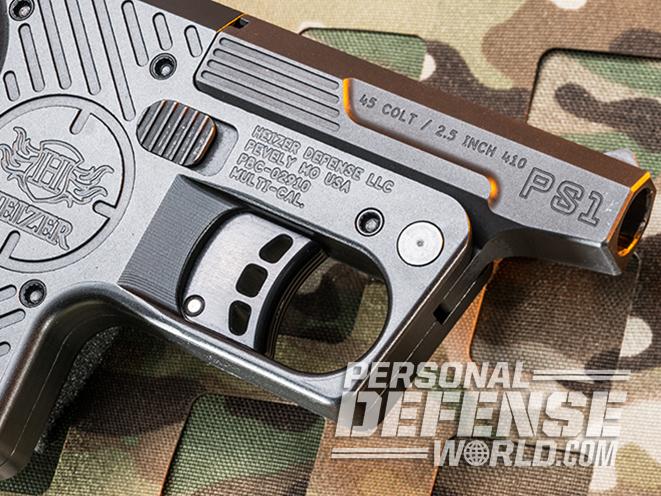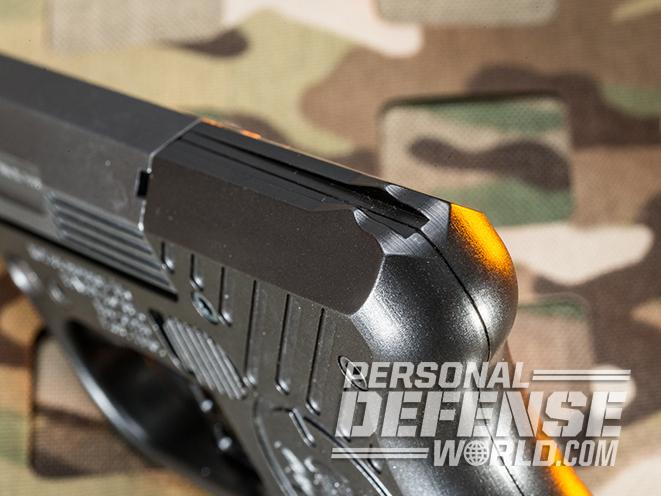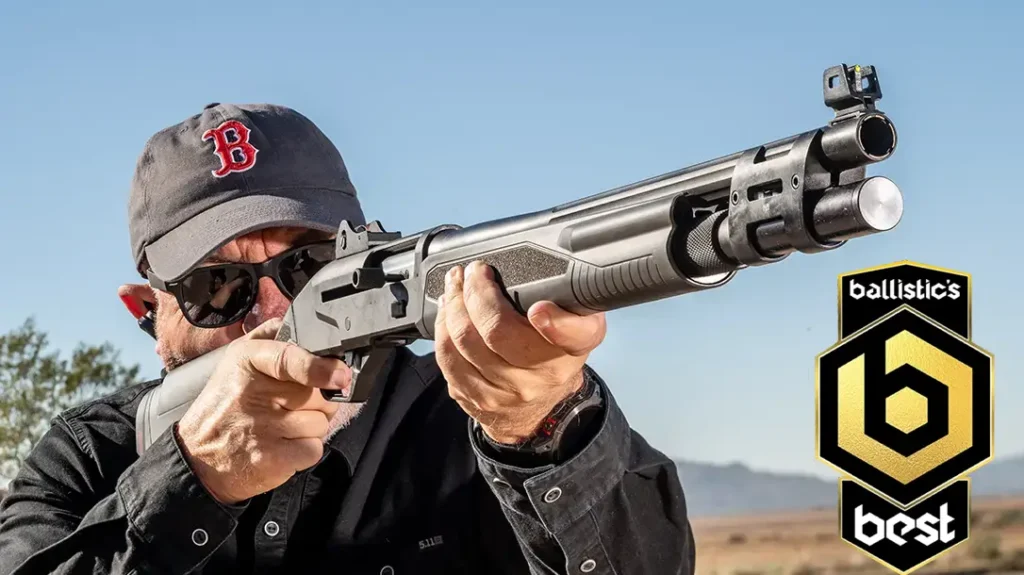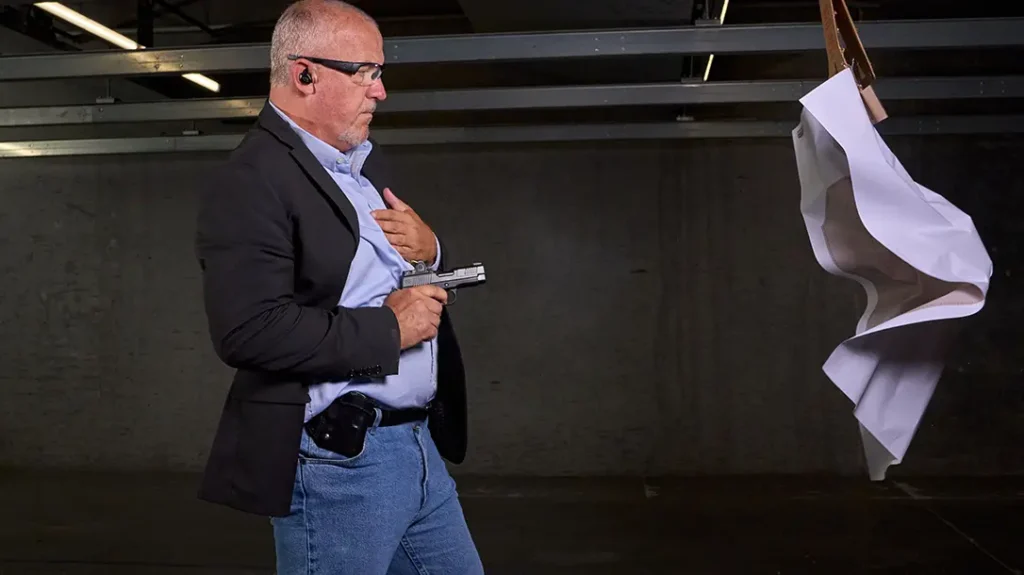During World War II, our government designed and produced a crude single-shot .45 ACP pistol called the Liberator. Mostly made from stamped steel with an unrifled barrel, the gun was intended to be distributed among allied resistance fighters in occupied territories. Small and easily concealed, the bare-bones gun would fit in the pocket of an insurgent who could quietly approach a lone enemy soldier, shoot them and take their rifle and ammunition. It was one method the resistance used to arm themselves with fighting rifles. So, the first time I saw the Heizer Defense Pocket Pistol, I wondered if the Liberator had inspired it.
Introduced in 2013, the Heizer Defense Pocket Pistol is a single-shot, break-action handgun. It was originally chambered for .45 Colt rounds and .410 shotshells, and the company later introduced barrel assemblies in .223 Remington and 7.62x39mm. In other words, you can change barrels and calibers quickly. And, unlike the WWII-era Liberator, the Heizer pistols are precision-manufactured from the finest materials available today. To understand the Heizer Defense pistols, however, we first need to know about the company’s founder, Charles Heizer.
Hello, Heizer
Charles Heizer was born in 1933 and lived in Hungary near the Austrian border. During the war, his village was first occupied by German and later Russian troops. Young Heizer scavenged discarded military equipment after the war and used his father’s blacksmith and machine shop to turn the junk into something he could sell. He’d often build farm equipment and motorcycles. Guns were of special interest to Heizer, however, and he once found a shotgun that had been damaged in the bombing. He rebuilt the gun and loaded his own shotshells using pieces of a lead pipe he cut with tin snips, which he used to put rabbit and quail on the family’s dinner table.
Advertisement — Continue Reading Below
- RELATED STORY: CCW Heat – Going Hot with the Heizer Defense PKO-45
Following his love for all things mechanical, Heizer received a bachelor’s degree in mechanical engineering and then a master’s degree in internal combustion engines from the Budapest Institute of Technology. Heizer escaped the Hungarian Communist Revolution in 1956 just months shy of receiving his doctorate degree. He arrived in the United States without any working knowledge of English, yet in a short time, he married another Hungarian refugee, started a family and established a machine shop. Aerospace contracts with Douglas Aircraft, Boeing, Lockheed, Airbus as well as many of their suppliers paved the road to success. With 55 years in business, Heizer Aerospace now occupies 300,000 square feet of manufacturing space.
But Heizer never abandoned his love of firearms, and using the excuse of diversifying, he established Heizer Defense to build guns. His extensive knowledge of steels, alloys and precision machining are as relevant to firearms as they are to aviation. Given Charles Heizer’s childhood and the volatile and uncertain politics we all experienced in the last few years, I had to wonder if the Heizer Pocket Pistol was intended as a modern-day Liberator.
Mini Guns
Heizer’s design is simple and robust, and his guns should last several lifetimes without problems. Constructed from aerospace-grade stainless steel, the gun weighs between 21 and 23 ounces unloaded depending on which barrel is installed. But perhaps the Pocket Pistol’s greatest attribute is that is amazingly thin—measuring just 0.72 inches!
Advertisement — Continue Reading Below
There are no sharp edges on the Pocket Pistol. All of its edges are rounded and well contoured. You’ll notice the heel of the pistol’s butt is exaggerated, and this feature locks the gun positively into the shooter’s hand. This feature, combined with the extremely low bore axis, makes the gun tolerable with the shotgun and 7.62x39mm rounds.
Heizer machines the frame in two halves and connects them with five screws. The trigger rides on ball bearings, and the pull is extremely smooth, but heavy, at around 13 pounds. There is no external or manual safety, so the long, heavy trigger pull is necessary for safety’s sake. Each trigger pull cocks and releases the firing pin striker. It does not rely on the barrel being opened to cock it, so if a round fails to fire, it has a double-strike capability.
The ambidextrous, spring-loaded barrel latch pushes forward to release the barrel’s lower lug, which allows the barrel, also under spring pressure, to pop up. The extractor will pull the empty round partially from the chamber but does not eject it, which is a plus for those of us who reload. Placing a round in the chamber and pushing down on the chamber end of the barrel until it locks in place will ready the gun for the next shot. Care must be taken with this short-barreled gun to not cover yourself or hand while loading the gun.
Advertisement — Continue Reading Below
To change barrels on the Pocket Pistol, push forward on the barrel latch and allow the barrel assembly to tip up. Check to make sure the barrel is unloaded, and then push out the pin, which the barrel pivots on, at the front of the frame. Always push it out from left to right. Once the pin is removed, the barrel will easily lift out of the frame. Select the next barrel you want to shoot and line up the barrel’s retaining pin hole and reinsert the barrel retaining pin—this time from the right side. Push the barrel down to make sure it locks without any problems and you’re ready to shoot.
Rounds Downrange
The Heizer Pocket Pistol can be purchased in a single caliber, and other barrels can be bought at a later date. Or the gun can be bought as a set with multiple calibers. Heizer Defense sent me the full selection of barrels chambered in .223 Remington, .45 Colt/.410 and 7.62x39mm. The .223 Remington barrel can be purchased with or without porting while all of the 7.62x39mm barrels possess porting. The .45 Colt/.410 barrel is not available with ports.
Because of the short barrel length, I fired all of the groups at 10 yards. I did not have a great variety of .45 Colt or 7.62x39mm ammo, but I would not expect group sizes to differ dramatically regardless of brand or bullet weight. To put it bluntly, the Heizer Pocket Pistol is designed for up close and personal work, and frankly, 10 yards is a stretch for this gun.
Advertisement — Continue Reading Below
I fired all of the five-shot groups from a seated rest utilizing a Millett BenchMaster for support. The long, heavy trigger pull made it tough to keep the sights aligned until the shot broke, yet somehow I managed to keep all of my groups under 2 inches at 10 yards. The sights on the Pocket Pistol are nothing more than a simple post front sight on the barrel and a groove in the top of the frame. There is no provision for windage or elevation adjustments, though all of the barrels were well regulated and shot to the point of aim.
- RELATED STORY: Pocket Shotguns – 6 Defensive .410/.45 Colt Derringers
With the .223 Remington barrel installed, I backed up to 100 yards and fired 10 shots at my MGM BC-C Zone steel target (basically a USPSA-sized target with the D-zone removed) and made seven hits aiming at the point where the head meets the body.
Before heading out to the desert, I had stopped at my local grocery store to buy several cantaloupes. Using Federal’s 2½-inch 000 buckshot shells, I fired at the fruit from slightly more than an arm’s length distance. Each round holds four 000 buckshot pellets, with each pellet weighing 70 grains. With a velocity of 644 fps and about 257 foot-pounds of energy (fpe), these rounds were predictably destructive and demonstrative of what the gun might do to a would-be carjacker. Firing these same loads on paper at 7 yards, I found the four pellets typically strung vertically between 7 and 8 inches.
Advertisement — Continue Reading Below
Of course, the velocity through these short barrels is much lower than when fired in a carbine. For instance, the Federal 55-grain .223 Remington load was 66-percent slower than when fired in a 16-inch-barreled carbine and had 85-percent less energy. The 7.62x39mm load was not quite as dramatic but still only generated 48-percent velocity compared to a 16-inch-barreled gun and 77-percent less energy. I didn’t have a .45 Colt carbine for comparison, nor do I own a .410 shotgun. Suffice it to say that these short barrels dramatically affect velocity and corresponding energy. However, they do still present a very formidable force to those wishing to harm someone armed with a Pocket Pistol.
One Versatile Gun
I had a lot of fun shooting the Heizer Pocket Pistol with each of the three barrels. My favorite was the .223 barrel which, once I got used to the fireball, was as easy to shoot as any 9mm gun. The recoil was very mild, and thanks to the extremely low bore axis, the muzzle lift was negligible. The 7.62x39mm and .45 Colt barrels are not quite as pleasant to shoot but certainly aren’t painful in any way. I had a great deal of fun throwing clay targets with one hand and shooting at them with the other. In short order, I had burned through two boxes of Remington 2½-inch #6 shells.
If you’re like me, you probably have a good supply of .223 and 7.62x39mm ammo stockpiled. The Heizer Defense Pocket Pistol can also help you burn up that extra ammo. If you run a trapline or hunt, the gun is perfect for administering a coup de grace shot. Its small size might make it a great choice for gator hunters or deep-sea fishermen or even hikers in bear country.
Advertisement — Continue Reading Below
With MSRPs between $399 and $449, the Heizer Defense Pocket Pistol is an intriguing solution to whatever question you might pose.
Heizer Defense Pocket Pistol Specs
| Caliber: .223 Remington, .410/.45 Colt, 7.62x39mm |
| Barrel: 3.25 or 3.75 inches |
| OA Length: 5.58-6.15 inches |
| Weight: 21-23 ounces (empty) |
| Grips: Stainless steel |
| Sights: Fixed |
| Action: DAO |
| Finish: Black or stainless |
| Capacity: 1 |
| MSRP: $399-$449 |
For more information, visit heizerdefense.com.
This article was originally published in “Combat Handguns” November/December 2017. To order a copy and subscribe, visit outdoorgroupstore.com.
Advertisement — Continue Reading Below
